At the top of the world and nowhere to go?
Thursday 14 September, 2023
Lying in wait at the bottom of a small babbling stream is a voracious predator. With piercing jaws agape, this ambush hunter is waiting for an unfortunate victim to swim past. You wouldn’t usually consider an insect the size of your thumb to be one of the top predators of any stream, but the nymph of the endangered Alpine stonefly (Thaumatoperla alpina) is one of the Victorian alps top freshwater predators, hunting the larvae of other insects.
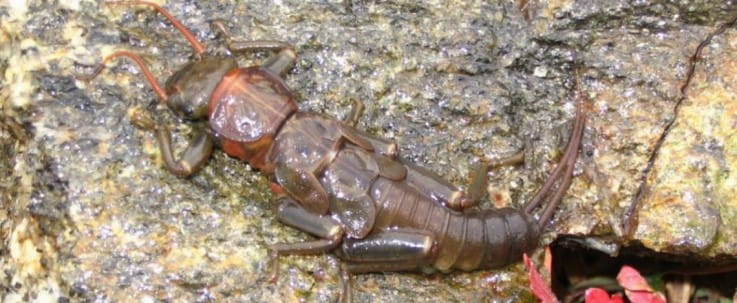
As the largest stonefly in Australia, this species spends approximately three years in its nymph stage before turning into an adult. Image credit: Cassandra Bryce.
The entire alpine ecosystem is one of Victoria’s most special and biodiverse landscapes. It totals over 900,000 hectares within the state’s alpine and eastern highland areas and is equivalent to at least 225,000 MCG’s worth of land! This region is home to a staggering one third of all known plant species in the state but is at risk of disappearing entirely.
Human-induced climate change has arrived on Victoria’s doorstep. With a possible four-degree rise in average temperature slated for 2100 by the Intergovernmental Panel on Climate Change (the world’s most authoritative body on this topic), it begs the question: what does the future look like for this snow-rich habitat? It’s a question that is hard to answer and is dictated by how we react in the next few years.
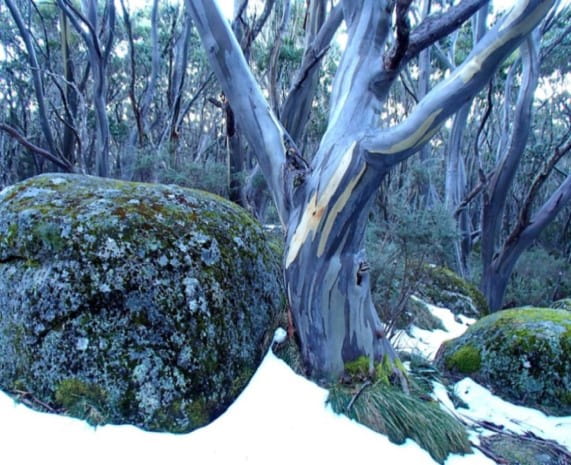
The strikingly stripey Snow Gums (Eucalyptus pauciflora) that occur at altitudes of 1,500 m have been shown to increase snow accumulation and moderate snow melt, making them critically important to the water resources of the region. Image credit: Ian Foletta.
As one of the land managers looking after these regions, Parks Victoria has a tremendously difficult job ensuring the future of the Victorian alps. The conservation and management plans initiated and delivered in the next decade could determine the survival of numerous species and entire vegetation classes.
Before we talk about what this conservation work looks like, we really need to understand what the overarching threats to this landscape are. Let’s dig into the issues.
"Humans being humans"

“A song of ice and fire?” – A changing climate

A scorched earth: this image showcases the aftermath of the 2003 Eastern Victorian Alpine bushfires, exposing the burnt-out hillsides near Anglers Rest. Image credit: John O’Neil.
The impacts of human induced climate change will vary greatly in the alps, and this will result in changes to snow cover, stream flows and extreme temperature thresholds. Natural forms of erosion in the alps include rainfall and snowmelt, but with more severe storms projected on average, this will impact erosion in the region significantly. By far one of the most critical issues of a warming climate is the higher frequency of large-scale wildfires in a landscape that does not react well to fire.
Over 90 per cent of the known area managed by Parks Victoria has been burnt by large scale bushfires in recent times. Some plant communities in Victoria may benefit from regular ecological burns (such as the grasslands in the western districts) but, this is not true of the alpine areas. Repeated major bushfires over the last two decades have decimated known conservation zones, and many old growth areas may take more than 300 years to fully recover from these effects.
A warmer climate could also see a marked change in flora and fauna to the subalpine and alpine regions, and a staggered infiltration of tree species that are more tolerant to regular burns and warmer temperatures.
“Getting muddy with it” – Deer and horses
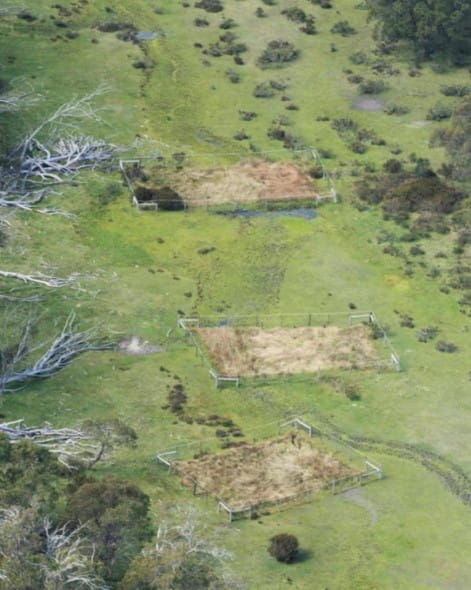
This image of Native Cat Flat (in March 2021) demonstrates the effects of overgrazing and trampling by feral horses. The only remaining habitat for wetland-dependent plants occurs within the fenced enclosures, which are maintained by Parks Victoria. Image credit: Parks Victoria
Deer and horses have hard hoofs on the soles of their feet. This adaptation is not found in any native Australian animal in the region, and they unwittingly devastate the alpine landscape by turning areas of soft mosses and sediment (such as the hugely biodiverse and federally protected alpine sphagnum bogs) into areas of mud and slop. Many of the plants that are trampled by invasive hoofed animals have very small windows of time to seed, which makes them particularly susceptible to land change.
The population of feral horses has rapidly increased in the last decade and urgent action is required to halt the dramatic escalation in the feral horse population and rate of ecosystem decline. Due to their much larger size, horses are seen as a much greater threat than deer in these areas, and if left unchecked, could wipe out entire ecological communities.
“My, what big teeth/mouthparts you have!” – Animal pests

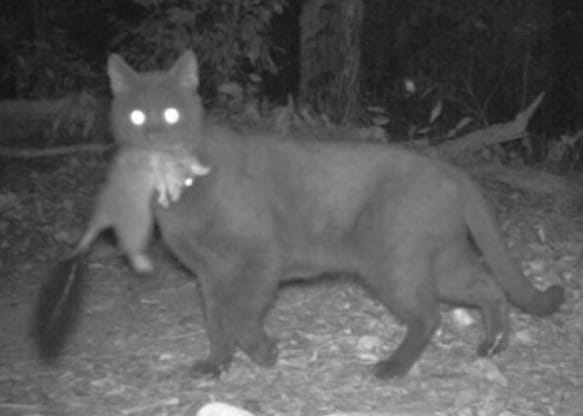
Foxes and feral cats are thought to kill a combined 2.6 billion animals in Australia every year. In the right-hand image, the vulnerable Brush-tailed Phascogale (Taun) is being dragged away by a feral cat. Image credit: Peter G Trimming and Marika Maxwell
There’s a long list of other invasive animal species to this landscape, and they all have the capacity to disrupt this delicate ecosystem. Foxes (Vulpes vulpes), feral pigs (Sus scrofa), feral goats (Capra aegagrus hircus), wild dogs (Canis lupus familaris), European rabbits (Oryctolagus cuniculus), European hares (Lepus europaeus) and feral cats (Felis silvestris catus) all devastate this landscape, and fundamentally alter what these areas looked like prior to European colonisation.
New pests have emerged from some unlikely places. One such species is a type of native wood-boring beetle (Phoracantha sp.). Known as a longicorn beetle, this group is renowned for eating the timber of trees. In their larval (grub-like) state, they burrow under the bark, and leave tell-tale bore holes and circular rings. Their presence in Snow gum habitat (Eucalyptus pauciflora) has decimated strongholds of this tree in the Victorian alps.

The circular borings of the longicorn beetle larvae can be easily seen on this dead Snow Gum. Image credit: Matthew Brookhouse.
It’s suspected that periods of prolonged drought may have stressed many snow gum trees, and the addition of numerous wood-boring larvae may have been enough to push them to the brink. Parks Victoria has partnered with numerous agencies to participate in the High Country Dieback Network to track where this dieback is occurring and develop future management plans.
“Close invasion of the weed kind” – Weed infiltration

To the untrained eye, this scene looks harmless. To a botanist, this infestation of Ox-eye daisy (Leucanthemum vulgare) is hard to look at. Image credit: CSIRO
The alpine environment has been highly infiltrated by weeds. Invasive plants such as English and Cape Broom, Willows, Ox-eye daisies, and Hawkweeds pose a significant threat to these unique ecological communities. English Broom in particular, has seed that can remain viable for over 80 years once established.
As with the native longicorn beetles, some threats have only emerged recently; it’s suspected that the three species of noxious Hawkweed (which can outcompete almost all other flora of its size) that are infiltrating the alps were accidentally brought into the landscape. At least one species of Hawkweed was introduced in Victoria through second-hand ski equipment brought in from New Zealand, where the noxious pest has completely displaced vast regions of alpine tussock grasslands in the South Island.

“Stuck in the middle with you” – Alpine Sphagnum Bogs
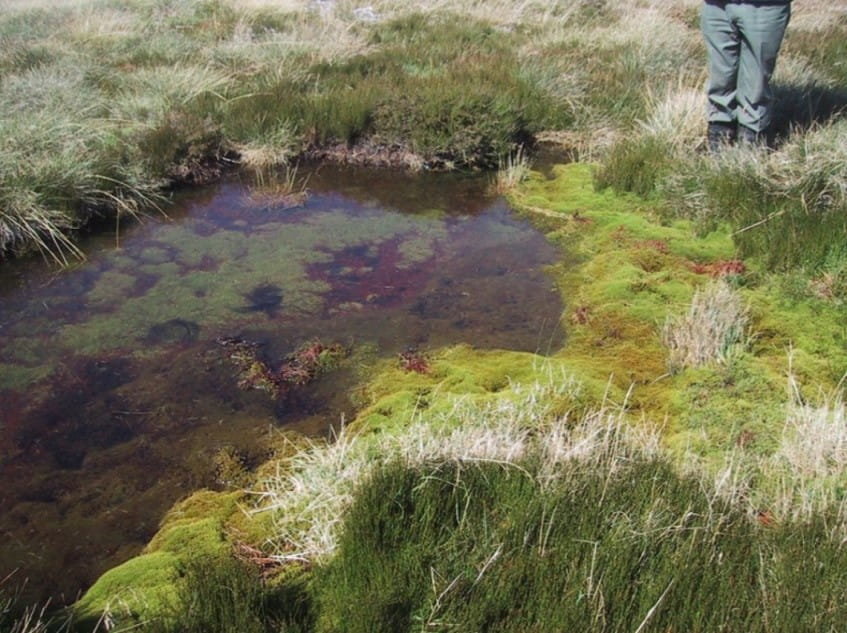
The light green moss pictured here is Sphagnum moss and can hold more than 20 times its own weight in water. Image credit: Parks Victoria
One of the rarer communities in the Victorian alps are the Alpine Sphagnum Bogs and Associated Fens. Many individual species are listed as threatened or endangered, including the critically endangered Mountain Burr-daisy (Calotis pubescens), which is known from only one location. These bogs are known for their crystal-clear pools and spongey sphagnum moss cover which act as a giant filtration system for the waters that feed major river systems.
Parks Victoria protects approximately 79% of all peatlands within the state. For the last decade, we’ve worked with partners, experts, and volunteers to establish effective invasive species control (from weedy plants like willows and soft rush, through to deer control and fire management) and routinely monitor these areas for any new establishing threats. This work has ensured their short-term survival, as we work with three Catchment Management Authorities: East Gippsland, North East, and West Gippsland.
“A sea of yellow and orange?” – Hawkweeds

It may not look like an aggressive daisy, but the Orange Hawkweed (Hieracium aurantiacum) endangers entire ecological communities in the alps. Image credit: Jo Caldwell
The Hawkweed Eradication Program is an intensive weed monitoring, survey, and control program for 3 species of Hawkweed which are all state prohibited. These yellow and orange flowers have devastated the south island of New Zealand and other parts of the world.
Monica Hersburgh, Area Chief Ranger of the Kiewa and Murray Park regions, states: “the weed can turn alpine herb field and grasslands, which are full of rare endemic flora and fauna species, into a monoculture of Hawkweed. We’ve been running this program for over 22 years and the data suggests we are heading on the right trajectory towards local eradication”.
Over the last year, over 1600 hours of hawkweed surveillance were conducted. The program is run in collaboration with Falls Creek Alpine Resort and DEECA.
“Protecting an alpine icon” – Fox baiting and feral cat control

Munching on the berry of a Mountain Plum Pine, the Mountain Pygmy Possum is considered critically endangered, with roughly 2000 individuals left. Image credit: North East CMA (captured by Grassland films)
The fox baiting program across the Bogong High Plains has been running since 2003. The Mountain Pygmy Possum (Burramys parvus) is a known food item of the red fox (Vulpes vulpes) and feral cats (Felis silvestris catus), with adult male possums and juveniles thought to be most vulnerable to predation during movements to and from core breeding habitats.
The loss of protective plant cover following fires greatly increased this possum’s exposure to feral predators. Combined with other impacts (such as fewer known breeding events and reduced availability of food and shelter), the need for a coordinated feral predator control program became apparent.
For more information on this program, check out our latest article: Back from the dead and back again? A Mountain Pygmy Possums tail.

The Long-footed Potoroo hops like a kangaroo but can use its tail to grasp objects. Just like the Mountain Pygmy Possum, the species was first known to western science in the late 1960s. Image credit: DEECA
The program was instigated to help protect the critically endangered Mountain Pygmy Possum but is continuing into 2023/24 and is being expanded to protect the Long-footed Potoroo (Potorous longipes).
“Changing the hoof print” – Feral horses and deer

These peat bogs are routinely destroyed by the actions of Sambar deer. Image credit: Parks Victoria.
Parks Victoria controls feral horses and deer as part of a combined approach to reduce their impacts, including removal from parks through targeted ground-shooting by professionals, and where feasible, through trapping and rehoming of feral horses.
For more information on feral horse management, check out our webpage on feral horses.
"A rocky relationship" – Conserving the Alpine Stonefly
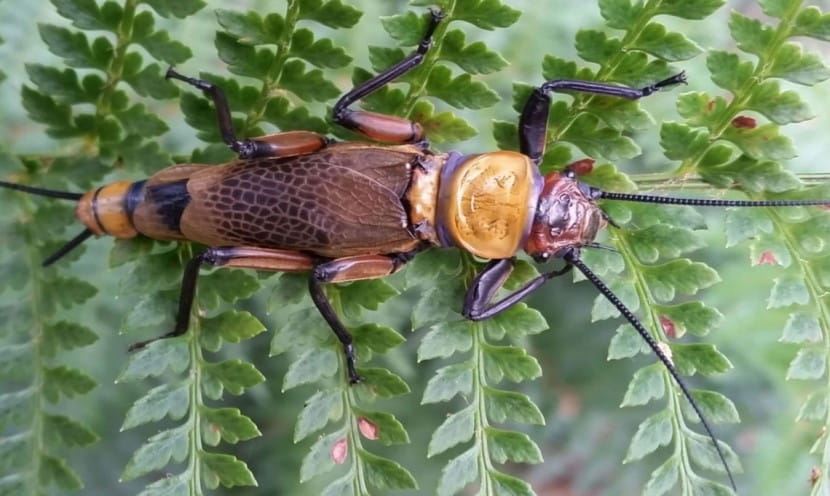
Insects aren’t appealing to everyone, but they perform enormously important ecosystem functions. Image credit: La Trobe University.
The adults may only live for two months to reproduce, but these threatened predators live in their larval stages for at least three years underneath the cobble bed of babbling streams. Their distribution is not well studied, and this highly limits how we can manage their recovery. La Trobe University has partnered with Parks Victoria and other agencies to identify key areas for their conservation, following the devastation of the 2019/2020 bushfire, and have previously utilised sniffer dogs to detect their odour.
The Alpine stonefly might be a tiny resident at the top of the continent, but it belies a bigger story. Stoneflies are generally considered indicators of stream health and their presence is a sign that an ecosystem is healthy. As their numbers have dwindled over the last two decades (due to repeated largescale fires and pests such as feral horses), long term monitoring and direct intervention are necessary to ensure species survival.
The initiatives launched by Parks Victoria encompassing pest management, the establishment of exclusion areas for native plants, and close cooperation with Traditional Owners, will be crucial for the future. The actions listed above are only a small fraction of the work Parks Victoria undertakes in this region.
Working closely with our partners, Parks Victoria is dedicated to providing these alpine species with a genuine opportunity to withstand the challenges presented by future climate change.




